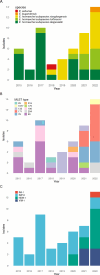Infections caused by clonal spread of metallo-beta-lactamase-producing Enterobacter cloacae complex isolates at a southern Taiwan hospital
- PMID: 40492759
- PMCID: PMC12210983
- DOI: 10.1128/spectrum.00234-25
Infections caused by clonal spread of metallo-beta-lactamase-producing Enterobacter cloacae complex isolates at a southern Taiwan hospital
Abstract
Carbapenem-resistant Enterobacter cloacae complex (ECC) has become a clinically important pathogen with increased incidence worldwide in recent years. In Taiwan, IMP-8 accounted for most carbapenemase produced by ECC in earlier studies. Clinical ECC isolates resistant to ertapenem, imipenem, and meropenem at the study hospital between 2014 and 2022 were collected at a medical center in southern Taiwan. The isolates were subjected to multilocus sequence typing, species identification by hsp60 sequencing, polymerase chain reaction detection of beta-lactamase genes, antimicrobial susceptibility tests, and whole genome sequencing analysis. Fifty-four ECC isolates causing infections were included. Bloodstream (20 episodes, 37.0%) and lower respiratory tract infections (14, 25.9%) were the common infection types. The crude in-hospital mortality was 51.8%. Carbapenemase genes were detected among 90.7% of the isolates, and blaIMP-8 remained to be the most common gene. The amikacin and colistin resistance rates were lower than 20%, while other agents were less active in vitro. Infections caused by ECC with extensive carbapenem resistance herald a poor prognosis and have limited treatment options. Clonal spread of blaNDM-1 harboring E. hormaechei subsp. xiangfangensis ST171 and blaVIM-1 harboring E. hormaechei subsp. hoffmannii ST78, which have not been reported in Taiwan, was responsible for the increased incidence of ECC with complete resistance to tested carbapenems since 2019.IMPORTANCEThis study reported the increase of carbapenemase-producing Enterobacter cloacae complex (ECC) isolates at a medical center in southern Taiwan during 2014 and 2022. The emergence of NDM-1-producing E. hormaechei subsp. xiangfangensis ST171 and VIM-1-producing E. hormaechei subsp. hoffmannii ST78, contrary to widely reported IMP-8-producing carbapenem-resistant E. cloacae complex, accounts for the increased incidence of health care-associated infections with few remaining treatment options and poor clinical outcomes. Our findings highlighted the changing antimicrobial resistance of carbapenem resistance among Enterobacterales, leading to clinical difficulties in Taiwan.
Keywords: Enterobacter cloacae complex; Taiwan; carbapenem-resistant Enterobacterales; carbapenemases.
Conflict of interest statement
The authors declare no conflict of interest.
Figures


Similar articles
-
Detection of different carbapenemases and clonality analysis of carbapenem-resistant Enterobacter cloacae.Acta Microbiol Immunol Hung. 2025 May 22;72(2):113-118. doi: 10.1556/030.2025.02604. Print 2025 Jun 20. Acta Microbiol Immunol Hung. 2025. PMID: 40402649
-
Polymyxin resistance in Enterobacter cloacae complex in Brazil: phenotypic and molecular characterization.Braz J Microbiol. 2024 Dec;55(4):3541-3550. doi: 10.1007/s42770-024-01464-1. Epub 2024 Aug 29. Braz J Microbiol. 2024. PMID: 39210190
-
Molecular Epidemiology and Clinical Characterization of Carbapenemase-Producing Enterobacter Species From an International Cohort.J Infect Dis. 2025 Jul 11;231(6):1489-1501. doi: 10.1093/infdis/jiae616. J Infect Dis. 2025. PMID: 39667036
-
Epidemiology and outcomes associated with MBL-producing Enterobacterales: A systematic literature review.Int J Antimicrob Agents. 2025 Apr;65(4):107449. doi: 10.1016/j.ijantimicag.2025.107449. Epub 2025 Jan 28. Int J Antimicrob Agents. 2025. PMID: 39884321
-
Epidemiology and clinical significance of carbapenemases in Australia: a narrative review.Intern Med J. 2024 Apr;54(4):535-544. doi: 10.1111/imj.16374. Epub 2024 Apr 8. Intern Med J. 2024. PMID: 38584572 Review.
References
-
- Weiner-Lastinger LM, Abner S, Edwards JR, Kallen AJ, Karlsson M, Magill SS, Pollock D, See I, Soe MM, Walters MS, Dudeck MA. 2020. Antimicrobial-resistant pathogens associated with adult healthcare-associated infections: summary of data reported to the national healthcare safety network, 2015–2017. Infect Control Hosp Epidemiol 41:1–18. doi: 10.1017/ice.2019.296 - DOI - PMC - PubMed
-
- European Centre for Disease Prevention and Control . 2023. Annual Epidemiological Report for 2019 – Healthcare- associated infections acquired in intensive care units
-
- Taiwan CDC . 2022. Annual report of healthcare-associated infection and antimicrobial resistance surveillance system
MeSH terms
Substances
Grants and funding
LinkOut - more resources
Full Text Sources
Research Materials
Miscellaneous

